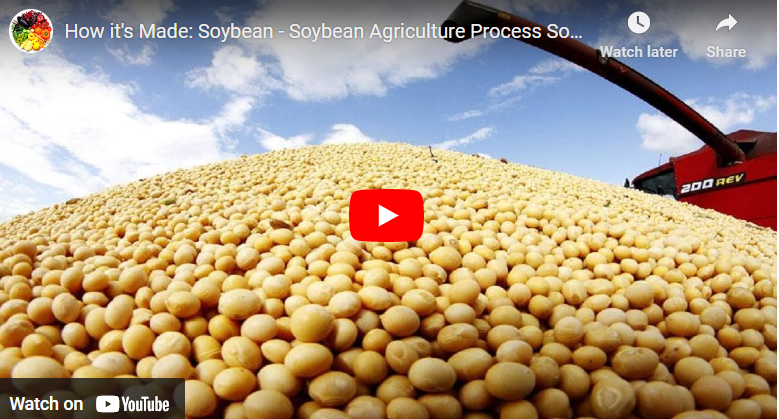Soybeans are a versatile crop that can be used for a variety of purposes, including making soybean oil, soy milk, tofu, and other soy-based products. Soybeans are also an excellent source of protein, making them a popular ingredient in vegetarian and vegan diets. However, before you can use soybeans in your favorite recipes, you need to process them.
Processing soybeans involves soaking, dehulling, conditioning, crushing and extracting oil. To begin, soybeans are soaked in water for several hours before the hulls are removed. Once the hulls are removed, the beans are conditioned by heating and adjusting moisture content. The beans are then crushed, which separates oil from the meal, and the oil is extracted from the meal. After the oil has been extracted, the meal is then dried and packaged for sale.
How To Process Soyabeans Step By Step Guide
Processing soyabeans gives you the liberty to prepare different variety of meal and allow you enjoy soyabeans meal in different form. We have carefully outline and explained the steps involved on how to process soyabeans from beginning to ending.
Read Also: How To Process Potatoes Flour
Step 1. Acquire your Soyabeans
Acquiring soybeans is the first step in processing them. You can either grow your own soybeans or purchase them from a local farmer or grocery store. When purchasing soybeans, make sure to select high-quality beans and inspect them for any damage or debris. Growing soybeans requires adequate soil, water, and sunlight. Regardless of how you acquire your soybeans, ensure they are clean and sorted before processing.
Step 2. Cleaning and Sorting Soybeans
The first step in processing soybeans is to clean and sort them. Soybeans may contain dirt, rocks, and other debris that needs to be removed before processing. Sorting soybeans involves removing any damaged or discolored beans.
Read Also: [Beginners Guide] How To Process Poundo Yam Flour
Here’s how to clean and sort soybeans:
- Pour the soybeans into a large bowl or container and pick out any debris, such as dirt or rocks.
- Rinse the soybeans in a colander under cold running water.
- Spread the soybeans out on a clean surface and sort through them to remove any damaged or discolored beans.
Read Also: How To Process Plantain Flour
Step 3. Crushing and Dehulling Soybeans
After cleaning and sorting, the next step in processing soybeans is to crush and dehull them. Crushing the soybeans separates the oil from the protein-rich meal, while dehulling removes the outer shell of the soybean.
Here’s how to crush and dehull soybeans:
- Place the soybeans in a soybean crusher and crush them to a fine powder. If you don’t have a crusher, you can use a blender or food processor to grind the soybeans.
- Transfer the crushed soybeans to a dehulling machine. The dehulling machine will remove the outer shell of the soybeans, leaving behind the soybean meal.
- Use a sieve to separate the soybean meal from any remaining hulls. The soybean meal can be used for making tofu, soy milk, and other soy-based products.
Read Also: How To Process Pepper
Step 4. Solvent Extraction
Solvent extraction is the process of extracting soybean oil from the soybean meal. The soybean meal is mixed with a solvent, such as hexane, which dissolves the oil. The oil is then separated from the solvent using a distillation process.
Here’s how to extract soybean oil using solvent extraction:
- Mix the soybean meal with a solvent, such as hexane, in a mixing tank. The solvent will dissolve the oil in the soybean meal.
- After mixing, the mixture is transferred to a distillation tank, where the solvent is removed from the oil using a distillation process.
- The soybean oil is then collected in a separate container.
Read Also: How To Process Palm Kernel Oil
Step 4. Refining Soybean Oil
After extracting the soybean oil, the next step is to refine it. Refining involves removing any impurities from the oil, such as free fatty acids, phospholipids, and other substances that can affect the quality and stability of the oil.
Here’s how to refine soybean oil:
- Heat the soybean oil in a deodorization tank to remove any unpleasant odors or flavors.
- Mix the soybean oil with an acid solution to remove any free fatty acids and other impurities.
- Add a degumming agent to the oil to remove any phospholipids.
- Heat the oil again to remove any remaining impurities.
- Filter the oil to remove any solids or remaining impurities.
Read Also: How To Process Okpa Flour
Step 6. Producing Soy Protein Isolate
The protein powder made from soybeans, known as soy protein isolate, is a superior-quality protein source. It is often used as a food ingredient in products like protein bars, meal replacement shakes, and other supplements.
Here’s how to produce soy protein isolate:
- Mix the soybean meal with water in a mixing tank to create a slurry.
- Adjust the pH of the slurry to around 9.5 using an alkaline solution, such as sodium hydroxide or potassium hydroxide. This helps to separate the protein from the other components of the soybean meal.
- Heat the slurry to around 85-90°C and maintain the temperature for around 30 minutes. This denatures the proteins in the soybean meal and helps to separate them from the other components.
- Centrifuge the slurry to separate the protein from the other components. The protein will form a solid mass, while the other components will remain in the liquid portion of the slurry.
- Wash the protein mass with water to remove any remaining impurities.
- Neutralize the protein mass by adding an acid solution to adjust the pH to around 7.
- Dry the protein mass to remove any remaining moisture. The resulting powder is soy protein isolate, which can be used as a food ingredient.
Read Also: How to Process Millet into Flour
Benefits of Processing Soybeans
- Processing soybeans offers a number of benefits. For one, soybeans are a rich source of protein, which can be isolated and used in a variety of food products.
- Soybeans also contain a range of nutrients, including vitamins, minerals, and antioxidants, that can promote health and prevent disease.
- Processing soybeans can increase their shelf life, making them more convenient to store and use.
- Soybeans can be processed into a wide range of products, from tofu and soy milk to soybean oil and soy protein isolate.
Read Also: How To Process Maize Into Flour
How to Preserve Processed Soybeans
Once soybeans have been processed, it’s important to store them properly to ensure their quality and freshness.
The best way to store processed soybeans is in an airtight container in a cool, dry place. Avoid exposure to moisture, heat, and sunlight, which can cause the beans to spoil or go rancid.
Processed soybeans can also be stored in the freezer for longer-term storage. If you’re unsure about the shelf life of your processed soybeans, check the packaging or consult with the manufacturer.
Read Also: How To Process Coconut Oil
How to Use Processed Soybeans
Processed soybeans can be used in a variety of ways, depending on the product. For example, tofu can be used as a meat substitute in stir-fries and other dishes, while soy milk can be used in place of dairy milk in baking and cooking.
Soybean oil is a flexible culinary oil that has the ability to be used for various cooking methods such as frying, baking, and sautéing. Soy protein isolate is a popular ingredient in protein bars, shakes, and other supplements.
When using processed soybeans, follow the instructions on the packaging or consult with a recipe for best results.
Read Also: How To Process Cassava to Garri
Disadvantages of Processing Soybeans
- While processing soybeans offers many benefits, there are some potential disadvantages to be aware of.
- For one, some people may be allergic to soybeans or have an intolerance to soy products.
- Soybeans are often genetically modified, which can be a concern for some consumers.
- Processing soybeans can involve the use of chemicals and other additives, which can have negative health effects if consumed in large quantities.
Read Also: How To Process Cashew Nuts At Home
Factors that Affect Soybean Processing
There are several factors that can affect the processing of soybeans. One of the most important is the quality of the beans themselves.
High-quality soybeans will yield better results than beans that are damaged or contaminated. The processing method used can also affect the quality of the final product.
Different methods may be used depending on the desired end product. For example, soy milk is typically made by soaking and grinding soybeans, while soy protein isolate is made through a more complex process that involves the use of chemicals and centrifugation.
Read Also: How To Preserve Spring Onions For Long Time Storage
Other factors that can affect soybean processing include temperature, pH, and the presence of enzymes and other substances that can affect the protein content and quality of the beans.
How Do You Process Soybeans At Home
Processing soybeans at home can be a relatively simple process. Here are the basic steps:
- Start by cleaning and sorting your soybeans. Remove any debris or damaged beans.
- Soak the soybeans in water for several hours or overnight. This will soften the beans and make them easier to process.
- Drain the water and rinse the beans thoroughly.
- Grind the soybeans in a food processor or blender until they form a fine powder.
- Begin by heating up a skillet or frying pan on medium heat. Add the soybean powder and cook for several minutes, stirring constantly, until the powder is lightly toasted and fragrant.
- Allow the powder to cool, then transfer it to an airtight container for storage.
Read Also: How to Preserve Yam for Long-Time Storage
Soya Beans Powder Uses
Soya beans powder can be used in a variety of ways, including as a protein supplement, a thickening agent in soups and sauces, and as an ingredient in baked goods like bread and muffins. It can also be added to smoothies or shakes for a protein boost.
How To Make Soya Beans Powder For Weight Gain
To make soya beans powder for weight gain, follow the steps outlined above for processing soybeans at home. Once you have the soybean powder, you can add it to smoothies or shakes for an extra protein and calorie boost. You can also mix the powder into oatmeal, yogurt, or other foods for a nutritious and filling snack.
Read Also: How To Preserve Watermelon For Long Time Storage
How To Make Soya Beans Powder With Groundnut
To make soya beans powder with groundnut, you’ll need to start with roasted groundnuts. Here’s how to do it:
- Roast the groundnuts in the oven or on the stovetop until they are lightly browned and fragrant.
- Allow the groundnuts to cool, then grind them in a food processor or blender until they form a fine powder.
- Follow the steps outlined above for processing soybeans at home.
- Once you have the soybean powder, mix it with the groundnut powder in a ratio of 2 parts soybean powder to 1 part groundnut powder.
- This mixture can be used in the same ways as plain soybean powder.
Read Also: How To Preserve Water Leaf For Time Storage
Soya Beans Powder Benefits
Soya beans powder is a rich source of protein, fiber, and a range of other nutrients. It’s also low in fat and contains no cholesterol, making it a heart-healthy choice.
Soya beans powder has been shown to have a range of health benefits, including reducing the risk of heart disease, diabetes, and certain types of cancer.
It’s also a great option for vegetarians and vegans looking for a plant-based protein source.
Read Also: How To Preserve Vegetables For Long Time Storage
How To Use Soya Beans Powder
Soya beans powder can be used in a variety of ways, including as a protein supplement, a thickening agent in soups and sauces, and as an ingredient in baked goods like bread and muffins.
It can also be added to smoothies or shakes for a protein boost. Simply mix the powder into your favorite foods and drinks for a nutritious and filling snack.
How To Make Soya Beans Powder For Baby
To make soya beans powder for baby, you’ll need to start with high-quality soybeans. Here’s how to do it:
- Clean and sort the soybeans, removing any debris or damaged beans.
- Soak the soybeans in water for several hours or overnight. This will soften the beans and make them easier to process.
- Drain the water and rinse the beans thoroughly.
- Grind the soybeans in a food processor or blender until they form a fine powder.
- Begin by heating a skillet or frying pan on medium heat. Add the soybean powder and cook for several minutes, stirring constantly, until the powder is lightly toasted and fragrant.
- Allow the powder to cool, then transfer it to an airtight container for storage.
Read Also: How To Preserve Tiger Nut For Long Time Storage
To use soya beans powder for your baby, you can mix it with breast milk or formula to create a nutritious and filling drink. You can also add the powder to pureed fruits and vegetables for a boost of protein and other nutrients. It’s important to introduce new foods to your baby gradually and watch for signs of allergic reactions.
How To Fry Soya Beans
Fried soya beans can make a delicious and nutritious snack. Here’s how to do it:
- Start by cleaning and sorting your soybeans. Remove any debris or damaged beans.
- Soak the soybeans in water for several hours or overnight. This will soften the beans and make them easier to cook.
- Drain the water and rinse the beans thoroughly.
- Heat a skillet or frying pan over medium heat. Add enough oil to cover the bottom of the pan.
- Add the soybeans to the hot oil and fry for several minutes, stirring occasionally, until they are lightly browned and crispy.
- Remove the soybeans from the pan using a slotted spoon and transfer them to a paper towel-lined plate to drain excess oil.
- Season the fried soybeans with your favorite spices and enjoy as a snack.
Read Also: How To Preserve Sweet Potatoes For Long-Time Storage
Conclusion
Processing soybeans is an important step in creating soy-based products, from soybean oil to soy protein isolate. By following these step-by-step instructions, you can successfully process soybeans at home and create your own soy-based products.
Whether you’re a vegan or just looking to incorporate more plant-based protein into your diet, soybeans are a nutritious and versatile ingredient to have in your pantry.




